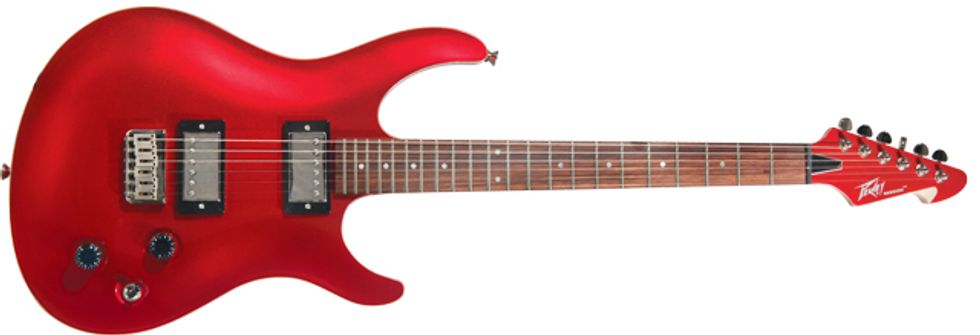Somewhere at a point where superhero paint-jobs, traditionally-inspired design, and a heavy-rocking attitude meet, lives the new Peavey Session. Developed with the intent to make a player’s instrument possessing exceptional versatility, this eye-grabbing electric brings both progressive and classic features together. And it does so at a sub-$500 price, which is particularly impressive in light of the way the Session follows through on its design intent.
In Session
At certain angles, the Session looks like a
descendent of both Fender and PRS lineages.
The body lives in a zone between an
augmented Strat-style shape (which is also
echoed in Peavey’s successful Predator series)
and the classic PRS double cutaway. The
body itself is crafted from lightweight, chambered
basswood and features a carved top and
scrape binding. The reflectivity of the gleaming,
red-metallic paint enhances the three-dimensionality
of the attractive top carve, and
the stripe of natural basswood along the top
edge of the body looks cool against the red
finish. A close look revealed a few spots where
the paint was just a little uneven, but that is
not entirely unusual for an affordably priced
instrument. On the other hand, the nut was
neatly slotted and the fretwork was excellent,
and I found the general quality to be quite
good where it counted.
Recessed push/pull Volume and Tone knobs enable coil-tapping of the Peavey-designed alnico humbuckers. The Fender-inspired string-through body, bridge with individually adjustable stainless steel saddles, and in-line tuners are time-honored and familiar features. But there’s plenty of modern design touches like the sculpted heel, a 9.5" to 15" compound-radius fretboard, graphite-composite nut, and dual-action truss rod. The rosewood fretboard on our review guitar had a complex grain pattern with attractive light and dark tones—a rare bonus for an instrument at this price point. And the Canadian maple neck has a smooth satin finish with a slim-to-medium C shape, which feels comfortable right up to the neck joint.
The instrument’s most engaging aspect, upon first handling, is its weight. At around 7 pounds, the Peavey feels well-balanced right away, and the neck profile and low-friction satin finish make the whole guitar feel effortless to handle whether you’re standing or sitting.
Roll On, Red Rocket
Acoustically, the Session is loud and
vibrant. The 25.5" scale gives the strings
a metallic zing and impressive snap, the
sustain is excellent along the entire length
of the fretboard, and string-to-string balance
is quite good as well. The chambered
body is resonant to the point of percepitble
reverberation when it’s unamplified, which
suggests well-chosen tonewoods as well as
sturdy and smart construction.
Plugged into a Carvin V3M amp with a 2x12 cabinet, I selected the bridge humbucker and chugged away at some power chords with a high-gain setting. In this setting, the Session was open-sounding, texture-rich, and fat with low end. And it was perfect for some Paul Gilbert-style shred—or at least my best attempt at it.
Dialing back the gain to a more moderate level, it was easy to conjure up some convincing Jimmy Herring-like lead tones. Not surprisingly, the Session captured the flavor of a humbucker-equipped Stratocaster—smooth, but less cutting than what you’d hear from single-coils. Tapping the outer coil of the bridge humbucker yielded twangier, glassier tones, though with less bite and clarity than, say, a Strat or Tele pickup. The orientation of the push/ pull pot is a little counterintuitive, with the aft-most knob (Tone) controlling the neck pickup and the front knob (Volume) controlling the bridge. Though it takes getting used to, Peavey says that orientation is based on players using the bridge pickup more frequently.
Switching to the neck humbucker, I was again impressed with the musicality of the tone. The Session is a breathy and bright-sounding guitar that can easily cut through the mix in a variety of musical settings. And the sounds coming out of my Fender Champ were spongy with impressive sustain, possessing a satisfying percussiveness that inspired more than a few Jimmy Nolen-styled funk licks. Multi-string slides felt natural on the medium tall, but rather wide frets. Bass notes were tight and dynamic as I thumbed around the guitar’s lower registers, and there was a nice emphasis in the mids and highs with an open-sounding quality that’s nice to hear from a neck humbucker.
The Verdict
The Peavey Session has a big, musical soul
that belies its $449 street price. It’s refreshing
to experience such fine tone and playability
from a value-priced instrument. Though it’s
unlikely the Session will put an end to the
quest for the perfect do-it-all guitar—particularly
for those with upmarket tastes—it
nevertheless exhibits an adaptable nature and
a varied identity that can range from muscular
to open and full of harmonic content.
If you’re trying to get more out of a single
guitar that looks and sounds pricier than it is,
it would be worth spending some time with
the Peavey Session.
Buy if...
you need tone balance in an affordable electric.
Skip if...
you’re in need of a more specific sounding guitar, or you can’t look past a few superficial, quality-control issues.
Rating...
Street $449 - Peavey Electronics Corporation - peavey.com |














![Rig Rundown: Russian Circles’ Mike Sullivan [2025]](https://www.premierguitar.com/media-library/youtube.jpg?id=62303631&width=1245&height=700&quality=70&coordinates=0%2C0%2C0%2C0)









